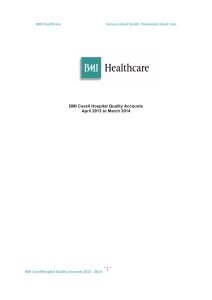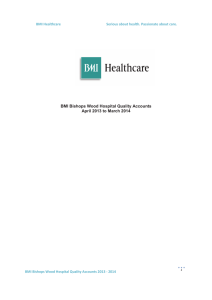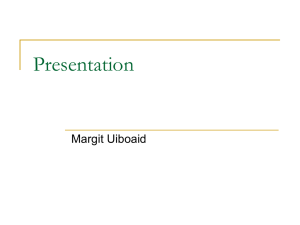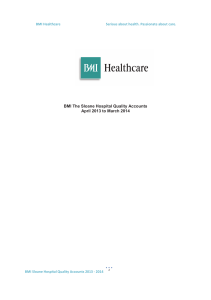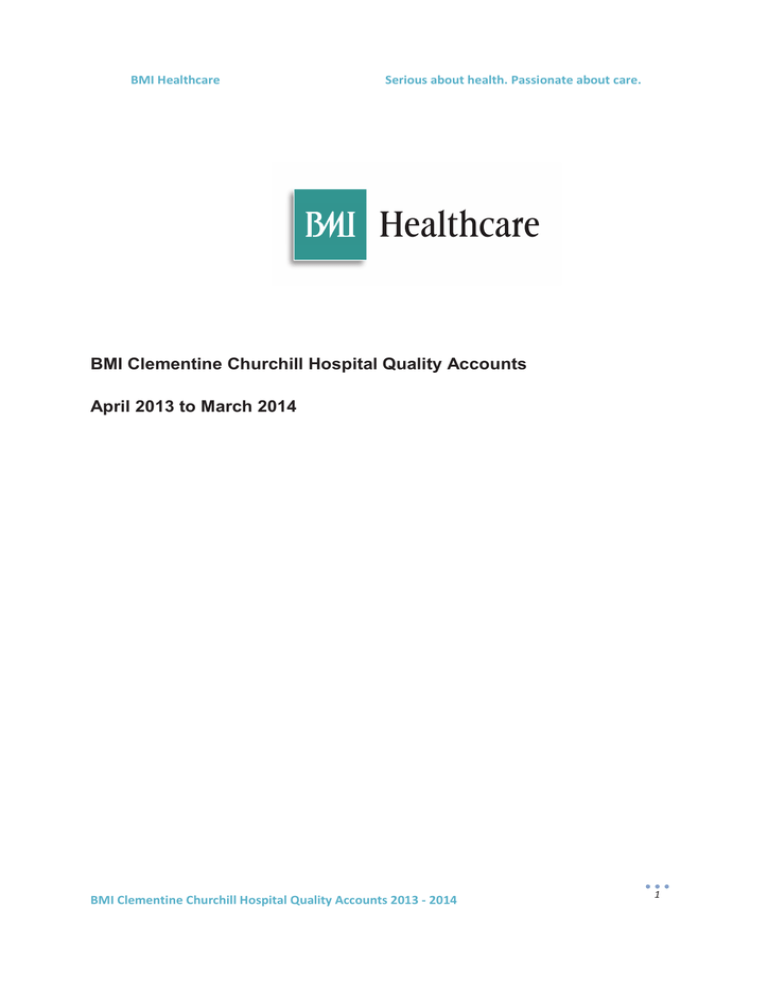
D/,ĞĂůƚŚĐĂƌĞ^ĞƌŝŽƵƐĂďŽƵƚŚĞĂůƚŚ͘WĂƐƐŝŽŶĂƚĞĂďŽƵƚĐĂƌĞ͘
BMI Clementine Churchill Hospital Quality Accounts
April 2013 to March 2014
D/ůĞŵĞŶƚŝŶĞŚƵƌĐŚŝůů,ŽƐƉŝƚĂůYƵĂůŝƚLJĐĐŽƵŶƚƐϮϬϭϯͲϮϬϭϰ
ϭ
D/,ĞĂůƚŚĐĂƌĞ^ĞƌŝŽƵƐĂďŽƵƚŚĞĂůƚŚ͘WĂƐƐŝŽŶĂƚĞĂďŽƵƚĐĂƌĞ͘
Chief Executive’s Statement
Welcome to our Quality Accounts 2014, the fifth year we have published this data. The
information presented here on a broad range of quality measures continues to grow in
importance and usefulness for patients and commissioners. Quality
accounts already provide a key metric for people to assess the strength
of our 66 hospitals and clinics against other facilities - NHS and
independent - from which they might receive their care.
For BMI Healthcare and every other private provider the importance of
comparable quality data was recently reinforced by the conclusions of
the Competition Commission’s market investigation into private
healthcare. From the outset of the inquiry BMI Healthcare supported the
principle that competition in the sector would be enhanced if private
hospitals produced comparable quality data, and that competition
amongst hospitals would drive up service standards. We were therefore
fully supportive when the Commission announced in April that it is
mandating the provision of greater information on the performance of
hospital operators and consultants. We wholeheartedly agree when the
Commission says that “a more transparent market with patients actively making choices will
drive hospital operators to compete on the things that matter to patients”.
Whilst we are yet to see how the Commission will ensure that this is enacted, the private sector
continues to take its own steps. Five years ago BMI Healthcare was at the forefront of the
sector’s efforts to be more open about sharing comparable quality and pricing data when we
sponsored the launch of the Hellenic Project. Today that work has been superseded by the
Private Hospitals Information Network which is working towards publishing data that will allow
patients and commissioners to make informed choices - a challenge that the sector must now
rise to. We at BMI Healthcare will continue to play our part in these important developments,
which we believe can have a significant role in driving higher quality standards.
I remain proud, but certainly not complacent, about the quality of care our hospitals provide.
Last year BMI Healthcare invested £40m in our hospitals, supporting our committed staff and
consultants to meet the challenge of providing consistently safe, high quality care. We
constantly measure our patients’ experience, and I am pleased to note that in the three months
to the end of March 2014, 97.3% of patients independently surveyed expressed satisfaction with
their care and 97.9% said they would recommend us to others. There is however always room
for improvement, and publication of comparable quality data across the independent sector can
only help.
The information available in these quality accounts has been reviewed by the Clinical
Governance Board and I declare that as far as I am aware the information contained in these
D/ůĞŵĞŶƚŝŶĞŚƵƌĐŚŝůů,ŽƐƉŝƚĂůYƵĂůŝƚLJĐĐŽƵŶƚƐϮϬϭϯͲϮϬϭϰ
Ϯ
D/,ĞĂůƚŚĐĂƌĞ^ĞƌŝŽƵƐĂďŽƵƚŚĞĂůƚŚ͘WĂƐƐŝŽŶĂƚĞĂďŽƵƚĐĂƌĞ͘
reports is accurate. I thank all the staff whose energy and devotion to improvement is
represented here and, more importantly, in the experiences of every patient who steps across
our threshold.
Stephen Collier, Group Chief Executive
D/ůĞŵĞŶƚŝŶĞŚƵƌĐŚŝůů,ŽƐƉŝƚĂůYƵĂůŝƚLJĐĐŽƵŶƚƐϮϬϭϯͲϮϬϭϰ
ϯ
D/,ĞĂůƚŚĐĂƌĞ^ĞƌŝŽƵƐĂďŽƵƚŚĞĂůƚŚ͘WĂƐƐŝŽŶĂƚĞĂďŽƵƚĐĂƌĞ͘
Hospital Information – BMI The Clementine Churchill
BMI The Clementine Churchill Hospital provides services to adults and children from 3 years of
age. We treat both private and NHS patients. The hospital has 141 beds with all rooms offering
the privacy and comfort of en-suite facilities, satellite TV, Wi-Fi and a telephone. The hospital
has five theatres, a minor surgery operating room, theatre endoscopy suite, a level III Intensive
Care Unit and a self-pay Walk-In Emergency Care Centre, open 7 days a week from 8am 10pm.
These facilities, combined with the latest in technology and on-site support services, enable our
consultants to undertake a wide range of procedures from routine investigations to complex
surgery. This specialist expertise is supported by caring and professional medical staff, with
dedicated nursing teams and resident medical officers on duty 24 hours a day, providing care
within a friendly and comfortable environment.
The hospital has committed to a rolling programme of refurbishment. This includes public areas
and patient bedrooms. We currently have working parties involved in the redevelopment of the
endoscopy unit, reconfiguration of the patient flow through theatres and modifications to preassessment.
We currently work with a range of payors, including CCG’s. NHS patients have the opportunity
to use our services under ‘Choose and Book’ and we also work with local trusts to fulfill ‘SPOT’
contract work which helps ensure patient waiting times are kept to a minimum where possible.
NHS patients make up 28% of our overall workload.
BMI Healthcare is registered as a provider with the Care Quality Commission (CQC) under the
Health & Social Care Act 2008. BMI Clementine Churchill Hospital is registered as a location for
the following regulated services:
•
•
•
Diagnostic and/or screening services, Physical disabilities, Sensory impairments
Surgical procedures
Termination of pregnancy
D/ůĞŵĞŶƚŝŶĞŚƵƌĐŚŝůů,ŽƐƉŝƚĂůYƵĂůŝƚLJĐĐŽƵŶƚƐϮϬϭϯͲϮϬϭϰ
ϰ
D/,ĞĂůƚŚĐĂƌĞ^ĞƌŝŽƵƐĂďŽƵƚŚĞĂůƚŚ͘WĂƐƐŝŽŶĂƚĞĂďŽƵƚĐĂƌĞ͘
•
•
•
Treatment of disease, disorder or injury
Caring for children (0 - 18yrs)
Caring for adults under 65 years, Caring for adults over 65 years.
The CQC carried out an unannounced inspection on 27 January 2014 and found that patients
were happy with their care and treatment and consent had been obtained prior to surgery.
The CQC identified 10 outcomes that had a minor or moderate effect on patient care. As a
result of this the Hospital Management team have devised a robust action plan. This ensures
there are reliable measures in place to enable embedded processes so every patient receives
high quality care in all stages of their journey through the Hospital.
The Clementine Churchill Hospital has a local framework through which clinical effectiveness,
clinical incidents and clinical quality is monitored and analysed. Where appropriate, action is
taken to continuously improve the quality of care. This is through the work of a multidisciplinary
group, Clinical Governance and Medical Advisory Committees. Regional Clinical Quality
Assurance Groups monitor and analyse trends and ensure that the quality improvements are
operationalised. At corporate level the Clinical Governance Board has an overview and provides
the strategic leadership for corporate learning and quality improvement.
There has been ongoing focus on effective reporting of all incidents, near misses and outcomes.
Data quality has been improved by continuing training and database developments. New
reporting modules have increased the range of fields for analysis and the speed at which
reports are available. This ensures the availability of information for effective clinical governance
with implementation of appropriate actions. This therefore helps prevent recurrences, improving
quality and safety for patients, visitors and staff.
At present we provide full, standardised information to the NHS, including coding of procedures,
diagnoses, co-morbidities and PROMs for NHS patients.There are additional external reporting
requirements for CQC, Public Health England (Previously HPA), CCGs and Insurers
BMI is a founding member of the Private Healthcare Information Network (PHIN) UK – where
we produce a data set of all patient episodes approaching HES-equivalency and submit this to
PHIN for publication. The data is made available to common standards for inclusion in
comparative metrics, and is published on the PHIN website http://www.phin.org.uk. This website
gives patients information to help them choose or find out more about an independent hospital,
including the ability to search by location and procedure.
D/ůĞŵĞŶƚŝŶĞŚƵƌĐŚŝůů,ŽƐƉŝƚĂůYƵĂůŝƚLJĐĐŽƵŶƚƐϮϬϭϯͲϮϬϭϰ
ϱ
D/,ĞĂůƚŚĐĂƌĞ^ĞƌŝŽƵƐĂďŽƵƚŚĞĂůƚŚ͘WĂƐƐŝŽŶĂƚĞĂďŽƵƚĐĂƌĞ͘
1.
Safety
1.1 Infection prevention and control
The focus on infection prevention and control continues under
the leadership of the Group Director of Infection Prevention and
Control and Group Head of Infection Prevention and Control, in
liaison with the Infection Prevention and Control Lead at The
Clementine Churchill Hospital.
We have had: •
3.951 cases of MRSA bacteraemia per 100,000 bed
days in the last year (NHS 1.17cases/100,000 bed days).
•
9.174 MSSA bactaeremia cases /100,000 bed days
•
3.951 E.coli bactaeremia cases/ 100,000 bed days
•
0 cases of hospital apportioned Clostridium difficile in the last 12 months.
•
SSI data is also collected and submitted to Public Health England for orthopedic surgical
procedures. Our rates of infection are;
o
o
Hips – 0.01%
Knees – 0
This data originated from an Infection Prevention and Control audit undertaken in December
2013 by the Group Infection Prevention and Control Nurse. There is an Action Plan in place
across Theatres, wards and ITU with a focus on hand hygiene training across clinical and nonclinical teams. We include this in our Induction Day training.
In readiness for a rollout of training this year, a benchmark audit was undertaken on ANTT and
care bundles.
Environmental cleanliness is also an important factor in infection prevention and our patients
rate the cleanliness of our facilities highly.
D/ůĞŵĞŶƚŝŶĞŚƵƌĐŚŝůů,ŽƐƉŝƚĂůYƵĂůŝƚLJĐĐŽƵŶƚƐϮϬϭϯͲϮϬϭϰ
ϲ
D/,ĞĂůƚŚĐĂƌĞ^ĞƌŝŽƵƐĂďŽƵƚŚĞĂůƚŚ͘WĂƐƐŝŽŶĂƚĞĂďŽƵƚĐĂƌĞ͘
1.2 Patient Led Assessment of the Care Environment (PLACE)
We believe a patient should be cared for with compassion and dignity in a clean, safe environment.
Where standards fall short, they should be able to draw their concerns to the attention of managers
and hold the service to account. PLACE assessments will provide motivation for improvement by
providing a clear message, directly from patients, about how the environment or services might be
enhanced.
In 2013 we introduced PLACE, which is the new system for assessing the quality of the patient
environment, replacing the old Patient Environment Action Team (PEAT) inspections.
The assessments involve patients and staff considering how the environment supports cleanliness,
privacy and dignity for the patient in addition to evaluation of the food and general building
maintenance. It focuses entirely on the care environment and does not cover clinical care provision
or how well staff are doing their job.
The PLACE audit for Clementine Churchill Hospital was carried out in May 2013 and involved four
patient assessors and four staff split into 2 teams, with results as follows:-
Cleanliness
Food
Privacy, Dignity &
Wellbeing
98.20%
93.98%
98.08%
D/ůĞŵĞŶƚŝŶĞŚƵƌĐŚŝůů,ŽƐƉŝƚĂůYƵĂůŝƚLJĐĐŽƵŶƚƐϮϬϭϯͲϮϬϭϰ
Condition,
Appearance &
Maintenance
97.06%
ϳ
D/,ĞĂůƚŚĐĂƌĞ^ĞƌŝŽƵƐĂďŽƵƚŚĞĂůƚŚ͘WĂƐƐŝŽŶĂƚĞĂďŽƵƚĐĂƌĞ͘
1.3 Venous Thrombo-embolism (VTE)
BMI Healthcare holds VTE Exemplar Centre status by the Department of Health across the
network of hospitals including BMI The Clementine Churchill Hospital. BMI Healthcare was
awarded the Best VTE Education Initiative Award category by Lifeblood in February 2013 and
was Runner Up in the Best VTE Patient Information category.
We see this as an important initiative to further assure patient safety and care. We audit our
compliance with our requirement to VTE risk assess every patient who is admitted to our facility.
The result of our audit on this shows a 90% compliance rate. We aim to improve by monthly
audits and updating training.
The Clementine Churchill Hospital reports the incidents of Venous Thromboembolism (VTE)
through the corporate clinical incident system. It is acknowledged that the challenge is receiving
information for patients who may return to their GPs or other hospitals for diagnosis and/or
treatment of VTE after discharge from the Hospital. As such, we may not be made aware of
them but we continue to work with our Consultants and referrers in order to ensure that we have
as much data as possible. These figures show that VTE incident numbers remain very low. Any
incidents are investigated and a root cause analysis is carried out. Appropriate treatment is
then administered.
Area
Total numbers 2013
DVT
PE
6
9
D/ůĞŵĞŶƚŝŶĞŚƵƌĐŚŝůů,ŽƐƉŝƚĂůYƵĂůŝƚLJĐĐŽƵŶƚƐϮϬϭϯͲϮϬϭϰ
Rate per 100 admissions
(2014)
0.05
0.076
ϴ
D/,ĞĂůƚŚĐĂƌĞ^ĞƌŝŽƵƐĂďŽƵƚŚĞĂůƚŚ͘WĂƐƐŝŽŶĂƚĞĂďŽƵƚĐĂƌĞ͘
2.0 Effectiveness
2.1 Patient reported Outcomes (PROMS)
Patient Reported Outcome Measures (PROMs) are a means of collecting information on the
effectiveness of care delivered to NHS patients as perceived by the patients themselves.
PROMs is a Department of Health led programme.
For the current reporting period, the tables below demonstrate that the health gain between
Questionnaire 1 (pre-operative) and Questionnaire 2 (post–operative) for patients undergoing
hip replacement and knee replacement at The Clementine Churchill Hospital.
Oxford Hip Score average
April 12 –
Mar 13
The
Clementine
Churchill
Hospital
England
Q1
Q2
Health gain between reporting
periods
24
40.429
16.429
17.907
39.224
21.317
Copyright © 2011 Re-used with the permission of The Health and Social Care Information Centre. All rights reserved.'
Oxford Knee Score average
April 12 –
Mar 13
The
Clementine
Churchill
Hospital
England
Q1
Q2
Health gain between reporting
periods
14.933
30.733
15.80
18.893
34.902
16.01
Copyright © 2013, The Health and Social Care Information Centre. All Rights Reserved.
We are currently not achieving the health gains for this group of patients when compared to the
outcomes achieved in the NHS.
We have several initiatives in place to maximise
improvements; these are all centered around the ERP programme within the hospital and are
detailed below.
D/ůĞŵĞŶƚŝŶĞŚƵƌĐŚŝůů,ŽƐƉŝƚĂůYƵĂůŝƚLJĐĐŽƵŶƚƐϮϬϭϯͲϮϬϭϰ
ϵ
D/,ĞĂůƚŚĐĂƌĞ^ĞƌŝŽƵƐĂďŽƵƚŚĞĂůƚŚ͘WĂƐƐŝŽŶĂƚĞĂďŽƵƚĐĂƌĞ͘
2.2 Enhanced Recovery Programme (ERP)
The ERP is about improving patient outcomes and speeding up a patient’s recovery after
surgery. ERP focuses on making sure patients are active participants in their own recovery and
always receive evidence based care at the right time. It is often referred to as rapid recovery
and is a new, evidence-based model of care that creates fitter patients who recover faster from
major surgery. It is the modern way for treating patients where day surgery is not appropriate.
ERP is based on the following principles:1.
a.
b.
All Patients are on a pathway of care
Following best practice models of evidenced based care
Reduced length of stay
2.
Patient Preparation
a.
Pre Admission assessment undertaken
b.
Group Education sessions
c.
Optimizing the patient prior to admission – i.e HB optimisation, control co-morbidities,
medication assessment – stopping medication plan.
d.
Commencement of discharge planning
3.
a.
b.
c.
d.
Proactive patient management
Maintaining good pre-operative hydration
Minimising the risk of post-operative nausea and vomiting
Maintaining normothermia pre and post operatively
Early mobilisation
4.
a.
b.
c.
d.
Encouraging patients have an active role in their recovery
Participate in the decision making process prior to surgery
Education of patient and family
Setting own goals daily
Participate in their discharge planning
A new team has been identified with key skills. This includes an orthopedic consultant, an
anaesthetic consultant, representatives from physiotherapy, pre assessment nurse, theatre,
ward nurse, pharmacist, Deputy Director of Nursing and Director of Diagnostics and
Physiotherapy Services with the support of the corporate ERP Lead.
The primary focus is on the development of the pre assessment services to educate patients in
achieving early mobilization and safe and timely discharge.
Greater emphasis is on a MDT approach to achieve the satisfactory outcome on AvLOS.
We are currently looking into the use of carbohydrate loading to facilitate enhanced recovery.
D/ůĞŵĞŶƚŝŶĞŚƵƌĐŚŝůů,ŽƐƉŝƚĂůYƵĂůŝƚLJĐĐŽƵŶƚƐϮϬϭϯͲϮϬϭϰ
ϭϬ
D/,ĞĂůƚŚĐĂƌĞ^ĞƌŝŽƵƐĂďŽƵƚŚĞĂůƚŚ͘WĂƐƐŝŽŶĂƚĞĂďŽƵƚĐĂƌĞ͘
2.3 Unplanned Readmissions within 31 days and unplanned returns to theatre.
Unplanned readmissions and unplanned returns to theatre are normally due to a clinical
complication related to the original surgery.
Comparing our readmission and unplanned return to theatre scores, it is evident that our
numbers have increased on the previous year. This can be attributed to an increase in
complexity and acuity of patients. These have a higher number of associated complications but
are still within the acceptable rate compared to other BMI sites.
D/ůĞŵĞŶƚŝŶĞŚƵƌĐŚŝůů,ŽƐƉŝƚĂůYƵĂůŝƚLJĐĐŽƵŶƚƐϮϬϭϯͲϮϬϭϰ
ϭϭ
D/,ĞĂůƚŚĐĂƌĞ^ĞƌŝŽƵƐĂďŽƵƚŚĞĂůƚŚ͘WĂƐƐŝŽŶĂƚĞĂďŽƵƚĐĂƌĞ͘
2.
Patient experience
3.1 Patient satisfaction
BMI Healthcare is committed to providing the highest levels of care to all of our patients. We
continually monitor how we are performing by asking patients to complete a patient satisfaction
questionnaire. Patient satisfaction surveys are administered by an independent third party.
We have working groups focussing on the 5 key areas for improvement, namely:
•
•
•
•
•
Discharge
overall quality of catering
hospital décor
nursing
admission.
D/ůĞŵĞŶƚŝŶĞŚƵƌĐŚŝůů,ŽƐƉŝƚĂůYƵĂůŝƚLJĐĐŽƵŶƚƐϮϬϭϯͲϮϬϭϰ
ϭϮ
D/,ĞĂůƚŚĐĂƌĞ^ĞƌŝŽƵƐĂďŽƵƚŚĞĂůƚŚ͘WĂƐƐŝŽŶĂƚĞĂďŽƵƚĐĂƌĞ͘
3.2 Complaints
In addition to providing all patients with an opportunity to complete a satisfaction survey, BMI
The Clementine Churchill Hospital actively encourages feedback both formally and informally.
Patients are supported through a robust complaints procedure, operated over three stages:
Stage 1: Hospital resolution
Stage 2: Corporate resolution
Stage 3: Patients can refer their complaint to independent adjudication if they are not satisfied
with the outcome at the other 2 stages.
Number of Complaints Received, October 2013-March 2014.
D/ůĞŵĞŶƚŝŶĞŚƵƌĐŚŝůů,ŽƐƉŝƚĂůYƵĂůŝƚLJĐĐŽƵŶƚƐϮϬϭϯͲϮϬϭϰ
ϭϯ
D/,ĞĂůƚŚĐĂƌĞ^ĞƌŝŽƵƐĂďŽƵƚŚĞĂůƚŚ͘WĂƐƐŝŽŶĂƚĞĂďŽƵƚĐĂƌĞ͘
Complaints Received by Area (Oct 2013-March 2014)
31 complaints in this period were resolved informally. Specific trends are as follows:
Subject
Cancelled Surgery
Falls
Staff attitude
Communication
Lost Property
Reason
No pre assessment
No Paediatric nurse
Theatre list over run
2 accidents on ground
1 in room post operatively
Nursing staff (6)
Radiology Admin
Verbal (3)
Written (2)
Slippers/shoes (3)
Hearing Aids
D/ůĞŵĞŶƚŝŶĞŚƵƌĐŚŝůů,ŽƐƉŝƚĂůYƵĂůŝƚLJĐĐŽƵŶƚƐϮϬϭϯͲϮϬϭϰ
ϭϰ
D/,ĞĂůƚŚĐĂƌĞ^ĞƌŝŽƵƐĂďŽƵƚŚĞĂůƚŚ͘WĂƐƐŝŽŶĂƚĞĂďŽƵƚĐĂƌĞ͘
The complaints handling process is being enhanced in the following ways:
•
•
•
•
•
•
•
Devolvement of complaints handling to Department
Front line resolution of complaints
Analysing trends to identify recurring themes
‘Closing the loop’ – action to prevent recurrence.
Customer Engagement Training/Complaints workshop
Customer Care Rounds – early warning system
Patient feedback – agenda item at departmental meetings.
3.
CQUINS
The Clementine Churchill Hospital took part in CQUINs for North West London and East of
England. VTE risk assessments, the Friends and Family test, the Safety Thermometer, and
Catheter Care Bundles were monitored for both. Additionally, London audited Smoking
Cessation and Nutritional Assessments; the East of England audit included Post-Surgical
Follow-ups and Lifestyle Intervention Audit (raised BMI). The majority of CQUINs were achieved
last year.
4.
National Clinical Audits
The Clementine Churchill Hospital was eligible to participate in the National Joint Registry audit
and all joint replacements are submitted to this. BMI hospital data is available from page 196
onwards in the attached latest NJS report.
5.
Research
No NHS patients were recruited to take part in research.
6.
Priorities for service development and improvement
1.
Endoscopy unit development – Formal plans have been approved, operational process
has been completed, awaiting capital approval
2.
Hospital improvement plan – complete plan has been devised to comprehensively
address all outstanding issue
3.
‘Lean’ team – a 5 month improvement programme is being implemented at the hospital
to ensure patient pathways and hospital processes are maximally efficient.
4.
Recruitment and retention plan – focused on clinical staff.
D/ůĞŵĞŶƚŝŶĞŚƵƌĐŚŝůů,ŽƐƉŝƚĂůYƵĂůŝƚLJĐĐŽƵŶƚƐϮϬϭϯͲϮϬϭϰ
ϭϱ
D/,ĞĂůƚŚĐĂƌĞ^ĞƌŝŽƵƐĂďŽƵƚŚĞĂůƚŚ͘WĂƐƐŝŽŶĂƚĞĂďŽƵƚĐĂƌĞ͘
7.
Mandatory Quality Indicators
7.1 The value and banding of the summary hospital-level mortality indicator (SHMI) for
the Clementine Churchill Hospital for the reporting period. – This information is unavailable
Unit
Reporting Periods
(at least last
reporting periods)
National
two Average
Highest
Score
National Lowest
Score
National
7.2 The Clementine Churchill Hospital patient reported outcome measures scores for
(i)
Unit
Groin hernia surgery
Reporting Periods
(at least last
reporting periods)
Apr 12 – Mar 13
National
two Average
0.083
Highest
Score
0.157
National Lowest
Score
National
0.014
There were minimum numbers going through the process for groin surgery so The Clementine
Churchill Hospital was unable to be scored on this element.
(ii)
Unit
Varicose vein surgery
Reporting Periods
(at least last
reporting periods)
Apr 12 – Mar 13
National
two Average
-8.738
Highest
Score
8.172
National Lowest
Score
National
-15.918
No data was provided for varicose veins surgery.
(iii)
Hip replacement surgery
Unit
Reporting Periods
(at least last
reporting periods)
Apr 12 – Mar 13
National
two Average
21.280
Highest
Score
24.684
National Lowest
Score
National
17.214
No data was available for hip replacement surgery.
D/ůĞŵĞŶƚŝŶĞŚƵƌĐŚŝůů,ŽƐƉŝƚĂůYƵĂůŝƚLJĐĐŽƵŶƚƐϮϬϭϯͲϮϬϭϰ
ϭϲ
D/,ĞĂůƚŚĐĂƌĞ^ĞƌŝŽƵƐĂďŽƵƚŚĞĂůƚŚ͘WĂƐƐŝŽŶĂƚĞĂďŽƵƚĐĂƌĞ͘
(iv)
Knee replacement surgery during the reporting period.
Unit
Reporting Periods
(at least last
reporting periods)
Apr 12 – Mar 13
National
two Average
15.99
Highest
Score
20.37
National Lowest
Score
National
12.2
7.3 (i) The percentage of patients aged 0-14 readmitted to a hospital which forms part of
The Clementine Churchill Hospital within 28 days of being discharged from a hospital
which forms part of the hospital during the reporting period.
Unit
0%
Reporting Periods
(at least last
reporting periods)
Apr 11 - Mar 12
National
two Average
11.45
Highest
Score
14.35
National Lowest
Score
National
7.96
7.3.(ii)The percentage of patients aged 15 or over readmitted to a hospital which forms
part of the Clementine Churchill Hospital within 28 days of being discharged from a
hospital which forms part of the hospital during the reporting period.
Unit
0.4%
Reporting Periods
(at least last
reporting periods)
Apr 11 – Mar 12
National
two Average
10.01
Highest
Score
14.51
National Lowest
Score
National
5.54
7.4 The Clementine Churchill Hospital responsiveness to the personal needs of its
patients during the reporting period.
Unit
88.78%
Reporting Periods
(at least last
reporting periods)
2012-2013
National
two Average
68.1
Highest
Score
84.4
National Lowest
Score
National
57.4
The Clementine Churchill Hospital intends to improve this percentage score, and so the quality
of its services, by continuing to focus on patient satisfaction and drive through improvements in
response to patient feedback. The daily patient visits enable immediate actions to be taken to
rectify any issues.
7.5 The percentage of patients who were admitted to The Clementine Churchill Hospital
and who were risk assessed for venous thromboembolism during the reporting period.
Unit
97 %
Reporting Periods
(at least last
reporting periods)
Apr 13 – Jan 14
National
two Average
96
Highest
Score
100
D/ůĞŵĞŶƚŝŶĞŚƵƌĐŚŝůů,ŽƐƉŝƚĂůYƵĂůŝƚLJĐĐŽƵŶƚƐϮϬϭϯͲϮϬϭϰ
National Lowest
Score
National
79
ϭϳ
D/,ĞĂůƚŚĐĂƌĞ^ĞƌŝŽƵƐĂďŽƵƚŚĞĂůƚŚ͘WĂƐƐŝŽŶĂƚĞĂďŽƵƚĐĂƌĞ͘
The Clementine Churchill Hospital intends to improve this, and so the quality of its services, by
monthly audit of VTE risk assessments and a continual and ongoing focus on the importance of
carrying out VTE risk assessments for all patients.
7.6 The rate per 100,000 bed days of cases of C difficile infection reported within The
Clementine Churchill Hospital amongst patients aged 2 or over during the reporting
period.
Unit
0
Reporting Periods
(at least last
reporting periods)
Apr 12 – Mar 13
National
two Average
17.3
Highest
Score
National Lowest
Score
30.8
National
0
The Clementine Churchill Hospital considers this was achieved and will continue to be
mainlined through strict adherence to infection prevention and control polices and working
closely with our link consultant microbiologist and antibiotic prescribing management.
7.7 The number and, where available, rate of patient safety incidents reported within The
Clementine Churchill Hospital during the reporting period, and the number and
percentage of such patient safety incidents that resulted in severe harm or death.
Number of patient safety incidents reported
Unit
721
Reporting Periods
(at least last
reporting periods)
Apr 12 – Mar 13
National
two Average
44.55
Highest
Score
National Lowest
Score
1,810
National
0
Rate of patient safety incidents reported (Incidents per 100 Admissions)
Unit
6.1
Reporting Periods
(at least last
reporting periods)
Apr 12 – Mar 13
National
two Average
7.76
Highest
Score
National Lowest
Score
30.95
National
1.68
Number of patient safety incidents that resulted in severe harm or death
Unit
0
Reporting Periods
(at least last
reporting periods)
Apr 12 – Mar 13
National
two Average
0.64
Highest
Score
28
D/ůĞŵĞŶƚŝŶĞŚƵƌĐŚŝůů,ŽƐƉŝƚĂůYƵĂůŝƚLJĐĐŽƵŶƚƐϮϬϭϯͲϮϬϭϰ
National Lowest
Score
National
0
ϭϴ
D/,ĞĂůƚŚĐĂƌĞ^ĞƌŝŽƵƐĂďŽƵƚŚĞĂůƚŚ͘WĂƐƐŝŽŶĂƚĞĂďŽƵƚĐĂƌĞ͘
Percentage of patient safety incidents that resulted in severe harm or death (Incidents per 100
Admissions)
Unit
Reporting Periods
(at least last
reporting periods)
Apr 12 – Mar 13
0%
National
two Average
0.9
Highest
Score
2.9
National Lowest
Score
National
0.0
7.8 The percentage of staff employed by the (name of hospital) during the reporting
period, who would recommend the Clementine Churchill Hospital as a provider of care to
their family or friends.
Unit
Reporting Periods
(at least last
reporting periods)
2013
National
two Average
64.58
Highest
Score
96.43
National Lowest
Score
National
33.73
No figures available for staff recommendations.
8.
Non-Mandatory Quality Indicators
8.1 The percentage of patients who received care as inpatients or discharged from A &E
during the reporting period, who would recommend the Clementine Churchill Hospital as
a provider of care to their family or friends.
Unit
73.82%
Reporting Periods
(at least last
reporting periods)
Jun 13 – Jan 14
National
two Average
66.23
Highest
Score
94.38
National Lowest
Score
National
35.63
This response rate is above the national average. We are focusing on this quality indicator by
completing daily patient visits in which a member of the management team obtains feedback
regarding the patient experience, including the friends and family question and linking into the
Chief Nurse of England 6C’s.
D/ůĞŵĞŶƚŝŶĞŚƵƌĐŚŝůů,ŽƐƉŝƚĂůYƵĂůŝƚLJĐĐŽƵŶƚƐϮϬϭϯͲϮϬϭϰ
ϭϵ


